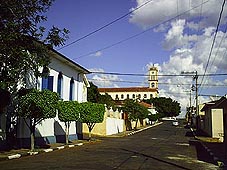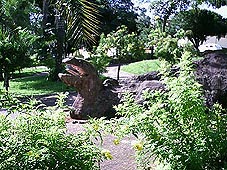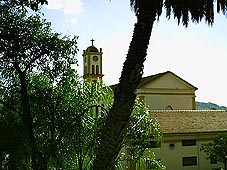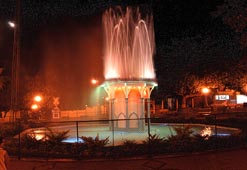
Old Mansions view in Matriz direction
HISTORICAL CITY

Luis Castenho de Almeida route the Goiás passed even so for our city in a Flag of arrested in 1671 if it knows that also Bartolomeu Bueno de Siqueira in 1670 passes for here in a very similar itinerary. Both had evidenced the existing presence of aboriginals for all the valley, but due to given, necessary greaters and register the historians attribute to the Flag of Luis Castenho de Almeida that it imprisons aboriginal in this region, integrating same the its expedition route the Goiás, the first one visit to these lands.
The localization of the valley was assigned for the river that a considerable amount of innumerable tamanduás withheld, animals these that the bandeirantes feared. Leaving São Paulo they they covered the hinterland, searching in the preaction of the aboriginal the way for its subsistence. Fearing these attacks a Surrounded "called town appeared here", safe place that the bandeirantes could make stops in its expeditions and as the proper name said, was a done surrounded place of trunks wooden that kept the aboriginals and tamanduás in the distance. And was in this place of "Surrounded" name that Bartolomeu Bueno da Silva made stop in 1722 in its expedition of prospection flag that passes in search of rocks and precious metals here.
Later it started to be Sesmaria - leasehold lands for the church and that they prepared the residents (indians) for the settling.
14 of May of 1835 São Simão were raised to the category of Chapel.
8 of March of 1842 were raised the Clientele.
22 of April of 1865 were created the City of São Simão.
12 of May of 1877 are created the Judicial district of São Simão.
4 of March of 1895 São Simão were raised the category of City.


São Simão had its proper Bank, as it had its proper electric plant, its railroads and its telephonic company, São Simão it had in the past great men with great initiatives and attracted innumerable immigrants as colonizedes: Germans, Frenchmen, North Americans, Lebaneses, Portuguese, Japanese, Italians and English.
São Simão also is known by having been the Cradle of the Announcement of the Republic, therefore in 31 of January of 1.888, the City council of São Simão, he considered the extinguishing of the monarchy and annulled to the formation of 3º empire. This event brought until our city Emperor D.Pedro II.
São Simão passed for three epidemics of yellow fever, 1.896/ 1.898/1.902 and for an epidemic of smallpox in 1.887. This advent made with that the headquarters of farm and its small villages of colonists, received a bigger amount from inhabitants in its roundness, this made with that small villages appeared that if they had later transformed into Chapels.
São Simão has much pride, in being able to have given to life the cities of our region: Cravinhos, Santa Rosa de Viterbo, Serrana, Sertãozinho, Ribeirão Preto, Pontal, Dumond, Guatapará, Serra Azul, Barrinha, Santa Rita do Passa Quatro, Luiz Antonio.
São Simão has privileged climate in virtue of the mountain ranges that surround it. Drinking waters and crystalline are found in abundance, what it makes it to be hidromineral ranch, climatic and tourist.
Typical provincial historical city, peaceful, that preserves in its streets of parallelopipeds and old mansions a history that seduces tourist and historians of some parts of the world.
Natural beauty also is attraction in the city, a cross of armed concrete that is more than the 40m of height in the high one of the Mount of the Cruise, where if can observe all the region, the Beach of the Tamanduá river with its crystalline waters, the Municipal Forest, the Square of the Republic, among others.

